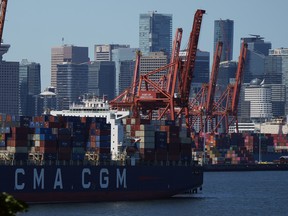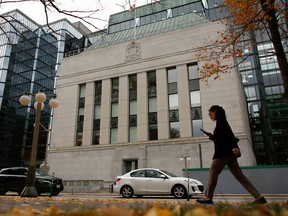Trade logged a fourth consecutive surplus
Article content
Canada’s trade logged a fourth consecutive surplus with economists expecting that will provide a boost to fourth-quarter gross domestic product and help the economy avoid a technical recession.
A surplus of $1.6 billion was recorded in November, according to Statistics Canada on Jan. 9, missing analyst estimates for a surplus of $2 billion. The agency also revised its trade numbers for October to a surplus of $3.2 billion from $2.97 billion.
Advertisement 2
Article content
Article content
Import value and volumes rose 1.9 per cent and 2.1 per cent, respectively, while exports pulled back 0.6 per cent in value — the first decline since June 2023 — and 0.3 per cent by volume.
“It looks like trade will add to fourth-quarter GDP growth, though we still have another month of data (and accompanying revisions) to go,” Shelly Kaushik, an economist with Bank of Montreal, said in a note on Jan. 9.
BMO estimates fourth-quarter GDP growth will come in flat, while CIBC Capital Markets estimates GDP will come in at 0.8 per cent annualized growth rate, matching the Bank of Canada’s projection in its most recent Monetary Policy Report.
In the third quarter, Canada’s GDP contracted 1.1 per cent. A technical recession occurs when growth contracts in two consecutive quarters.
“Exports for the quarter as a whole still look set to rise by roughly four per cent annualized owing to a strong start to the quarter, while imports will show a decline, making net trade a contributor to GDP growth,” economist Katherine Judge at CIBC World Markets said in a note on Jan. 9.
Export data for November is “a bit stronger than the overall decline might suggest,” said Stephen Brown, deputy chief economist for North America at Capital Economics Ltd., with most of the drop attributed to a 17 per cent month-over-month decline in aircraft exports, while metal and non-metallic mineral product exports fell 6.5 per cent.
Article content
Advertisement 3
Article content
Exports rose in seven of 11 categories, but only a combined total of one per cent, said CIBC’s Judge.
Tougher times lie ahead
Stephen Brown
However, economists are forecasting December trade data to mark a turning point for Canada’s economic picture.
“Tougher times lie ahead, with export orders seemingly falling fast in December,” said Brown, citing survey data from the S&P Manufacturing PMI (purchasing managers’ index) showing export orders slumping to 44.9 in December. An index reading below 50 indicates contraction.
On the import side, a 2.2 cent drop in imports of consumer goods, “leaves that category six per cent below year-ago levels,” and is “a sign of weak domestic demand,” Judge said.
Consumer goods imports also fell in October, economist David Rosenberg, head of Rosenberg Research & Associates Inc., said in his newsletter on Jan. 10.
“A large share of Canadian consumption relies on imported goods, so that’s a strong signal regarding the direction of consumer demand,” he said.
There were other signs of slowing economic activity, including a 1.5 per cent slowdown in motor vehicle imports.
Advertisement 4
Article content
That, coupled with the deceleration in consumer goods imports, signals that “retailers at least are now trying to run down their inventories,” Brown said, as the ongoing slowdown in consumer spending and higher interest rates make it too expensive to hold onto inventory.
“It makes sense to start trimming those inventories to cut costs,” he said in an email.
While the trade reflected a more difficult economic picture, it also contained some encouraging signs on inflation, Rosenberg said, noting that the import price index fell 0.2 per cent month over month and is up “a mere” 0.5 per cent year over year, while the consumer goods segment is down 1.6 per cent year over year.
Recommended from Editorial
-

Joe Biden not so different from Donald Trump on trade
-

Business between Canada, India continues despite tensions
-

Canada dodges technical recession but struggles to grow
Export prices fell 0.4 per cent in November after falling 0.7 per cent in October due to declining oil prices.
“All in, a supportive report for the BoC’s shift away from its hawkish posture. The likelihood that the bank cuts rates ahead of the (United States Federal Reserve) and the generally soft underlying details within this report pose dual downside risks for the Canadian dollar,” Rosenberg said.
• Email: gmvsuhanic@postmedia.com
Bookmark our website and support our journalism: Don’t miss the business news you need to know — add financialpost.com to your bookmarks and sign up for our newsletters here.
Article content
Trade could add to Canada’s Q4 GDP and help avoid technical recession
2024-01-10 21:00:06








